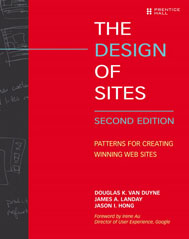Book Review: The Design of Sites
- By Matt Stephens
- January 20, 2007

The Design of Sites: Patterns for Creating Winning Web Sites (2nd Edition)
by Douglas K. van Duyne, James A. Landay, Jason I. Hong
Prentice Hall, December 2006
These days, blogging software and content management systems allow users with hardly an ounce of design sense to create professional-looking websites, using pre-fabbed “off-the-shelf” templates. But there’ll always be circumstances when you need to do it the old-fashioned way, and create a website design from scratch. And, even for off-the-shelf "armchair web designers", it's still important to have at least a basic understanding of web usability principles.
Luckily, for website design DIYers and professionals alike, there’s now a way to pick a pre-fabbed design off the shelf: the trend for patterns has reached the shores of Website Design Land.
The Design of Sites is a huge (1,000-page) book packed with website design patterns, all presented in full color. The thin pages and bold, color-coded presentation give the book a sort of Sears catalog feel; thumbing through the book searching for the right pattern is rather like searching for a PERMA-PREST(TM) wool-look jumper or a bonded-polyester Knit Pants set. But don’t let that put you off!
It would be an understatement to say that the web is a free-form medium. With so many different solutions for an ever wider range of problems, the world needs some systematic cataloging and pigeon-holing of all the disparate designs out there. And this book does an admirable job of doing just that. Patterns are grouped conceptually, starting with a high-level look at site genres: personal e-commerce, news mosaics, educational forums, blogs, and so on. Other pattern groups include: writing and managing content, building trust and credibility, basic e-commerce, advanced e-commerce, making navigation easy, speeding up your site, and so on.
There’s also a group of three patterns related to the mobile web: increasingly important, as more people access the web over 3G (or 3.5G now) mobile networks.
Within each group, the patterns are mostly task-oriented: so within the Making Navigation Easy group there’s a navigation bar pattern; and further patterns called Unified Browsing Hierarchy, Tab Rows, Obvious Links, Site Map etc.
When you drill down to the individual patterns, each one is presented in the traditional design pattern format: first some background info; then an exposition of the problem that this pattern solves; then the solution; and finally a discussion of some other patterns to consider. This cross-referencing is important, as no individual pattern represents a complete website design. Rather, they’re more like building blocks and cross-cutting aspects.
Each pattern includes a deliberately hand-sketched wireframe diagram, to illustrate the solution. For example, the Multiple Ways to Navigate pattern provides techniques that support how customers navigate sites. The Problem section introduces the burning issue: that customers navigate web sites in many ways; and if any of the key navigation tools are hard to find or missing, visitors will find the site tedious to use. The Problem section also introduces some motivators for applying this pattern; e.g. impulse (seeing an unexpected link) sometimes drives customers to act: witness all those “If you liked this, you’ll also like...” and “Other customers also purchased...” links on amazon.com.
The Browsable Content pattern (problem: “Browsing content on a site can be difficult if the information is not organized”) includes a screenshot of Walmart.com, illustrating its easy navigation and clear signals for users to find their way back to where they started. In fact, nearly every pattern includes a full-color screenshot of a real website to demonstrate proposed solution.
I can’t stress enough the huge amount of information available in this book: it’s something of a website designer’s dream. It’s written in an information-packed style: great for absorbing details quickly. The concise, dry style might become rather trying after a while, but luckily, the easy-on-the-eye layout and the accessible pattern format keep the book readable. Go get it, it’s a good one.